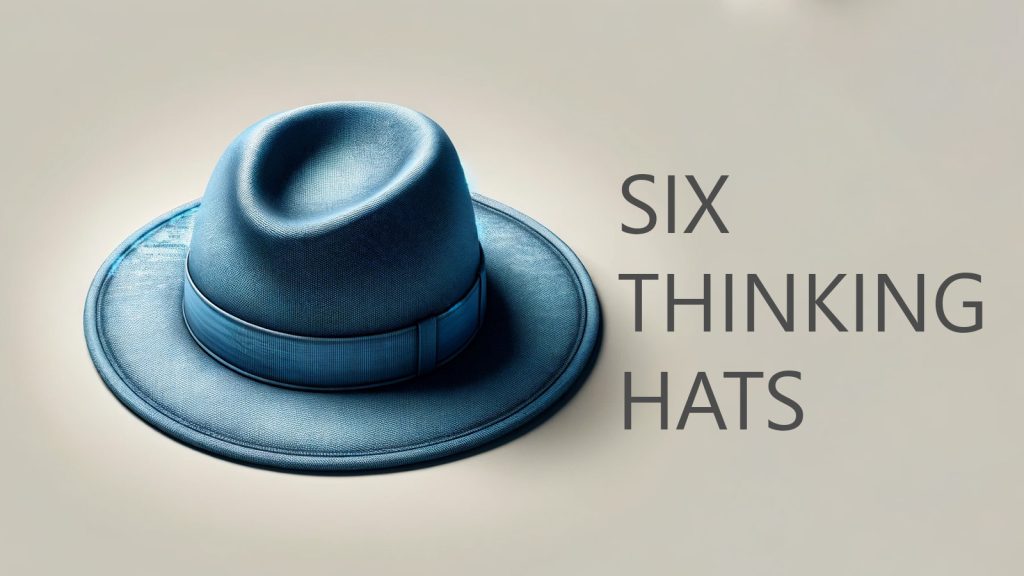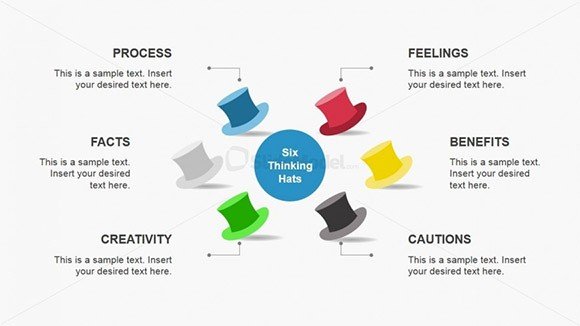Best Six Hat Thinking PowerPoint Templates
The six thinking hats technique offers a creative thinking tool for managers to solve problems and think differently while taking decisions, in meetings or even while making or executing plans.
The model was introduced by Edward de Bono and it offers a powerful tool for brainstorming ideas and help during innovation process. You can break down your thoughts into six parallel areas to get the full spectrum of alternatives from gut feeling to data analysis and help to take each viewpoint with a different discussion. Using the six thinking hats method, teams and groups can be more effective while approaching problem solving topics or generating new brainstorming ideas.

Here we will review some of the best premium & free six thinking hats templates for PowerPoint presentations and Google Slides that can help you to prepare slides using this method.
1. Free Six Hat Thinking PowerPoint Template
This free 6 hats PowerPoint template design contains many different slides inspired by the DeBono Six Thinking Hats model. You can download the template to prepare presentations in PowerPoint with colorful hat illustrations.

Download free Six Thinking Hats PowerPoint template design from SlideHunter.com.
2. Colorful Six Thinking Hats Template design for PowerPoint
If you require PowerPoint template designs ready for commercial presentations you can also download the Six Thinking Hats PowerPoint templates design from SlideModel.com – Becoming a subscriber at SlideModel you can also download more than 7000 creative PowerPoint graphics and slide elements to enhance your presentations.

The six thinking hats PowerPoint slide contains creative & colorful hat illustrations ready for PowerPoint that you can copy and paste into your own slides or reuse some of the pre-designed diagram layouts.

Download Six Thinking Hats PowerPoint Template from SlideModel.com.
While participating on any discussion or meeting, teams can use these six thinking hats exchanging them from blue, white, green, yellow, red to black. The following order organizes the discussion:
- The blue hat allows to start with an approach and process view.
- White hat helps to review the facts.
- The green hat let you generate new ideas without any judgement. It is like the brainstorming phase.
- The yellow thinking hat allows to put focus on the benefits.
- The red hat let bring emotional responses to any ideas.
- The black hat allows to apply critical thinking after the benefits and other ideas were explored.
Overview of the Six Thinking Hats
Here is a quick overview of each of the six thinking hats and its colors.
- White Hat: Focused on information and data. In this mode, participants concentrate on available data, look at what they know, and see what they can learn. It’s all about facts and figures.
- Red Hat: Signifies feelings, hunches, and intuition. When wearing the Red Hat, participants express emotions and feelings and share fears, likes, dislikes, loves, and hates, without the need for justification.
- Black Hat: Caution and critical judgment. It’s used to point out the weaknesses in an idea. This is a crucial hat as it helps to make plans more resilient and solid. It’s not about argumentation but about identifying potential problems.
- Yellow Hat: Optimism and the exploration of benefits. Here, participants explore the positives and probe for value and benefit. The Yellow Hat helps identify the value of an idea.
- Green Hat: Creativity and new ideas. This is where participants develop creative solutions to a problem. It’s a freewheeling way of thinking, in which there is little criticism of ideas.
- Blue Hat: Process control. The Blue Hat is used to manage the thinking process. It’s the hat worn by people chairing meetings, for example. When facing difficulties because ideas are running dry, they may direct activity into Green Hat thinking.
Some Scenarios for Real Life Application of Six Thinking Hats model (Scenario Examples)
- Problem-solving Meeting: In a brainstorming session presentation to tackle a specific problem, each hat is worn in turn to explore all facets of the issue. For instance, the team might use White Hat thinking to gather data about the problem, Red Hat thinking to understand personal responses to it, Black and Yellow Hat thinking to assess risks and benefits, Green Hat thinking to generate innovative solutions, and Blue Hat thinking to manage the process and summarize conclusions.
- Product Launch Presentation: During a presentation on a new product launch or in a GTM presentation, the team could use the Six Hats to evaluate the product from different perspectives. This approach ensures a balanced view, considering emotional responses (Red Hat), potential risks (Black Hat), optimism about the product’s success (Yellow Hat), and creative marketing strategies (Green Hat).
- Team Conflict Resolution: When addressing a team conflict, a facilitator might guide the team through the hats to ensure a comprehensive and empathetic understanding of the issues. The Red Hat allows team members to express emotions, while the White Hat focuses them on the facts. The Black and Yellow Hats help assess the pros and cons of potential solutions, and the Green Hat encourages creative problem-solving.
- Educational Settings: In a classroom, a teacher can use the Six Hats to guide students through a complex topic, ensuring they look at it from different angles. This not only deepens understanding but also teaches critical thinking and perspective-taking.
Alternatively you can download other business theories and model templates for Microsoft PowerPoint and Google Slides.
